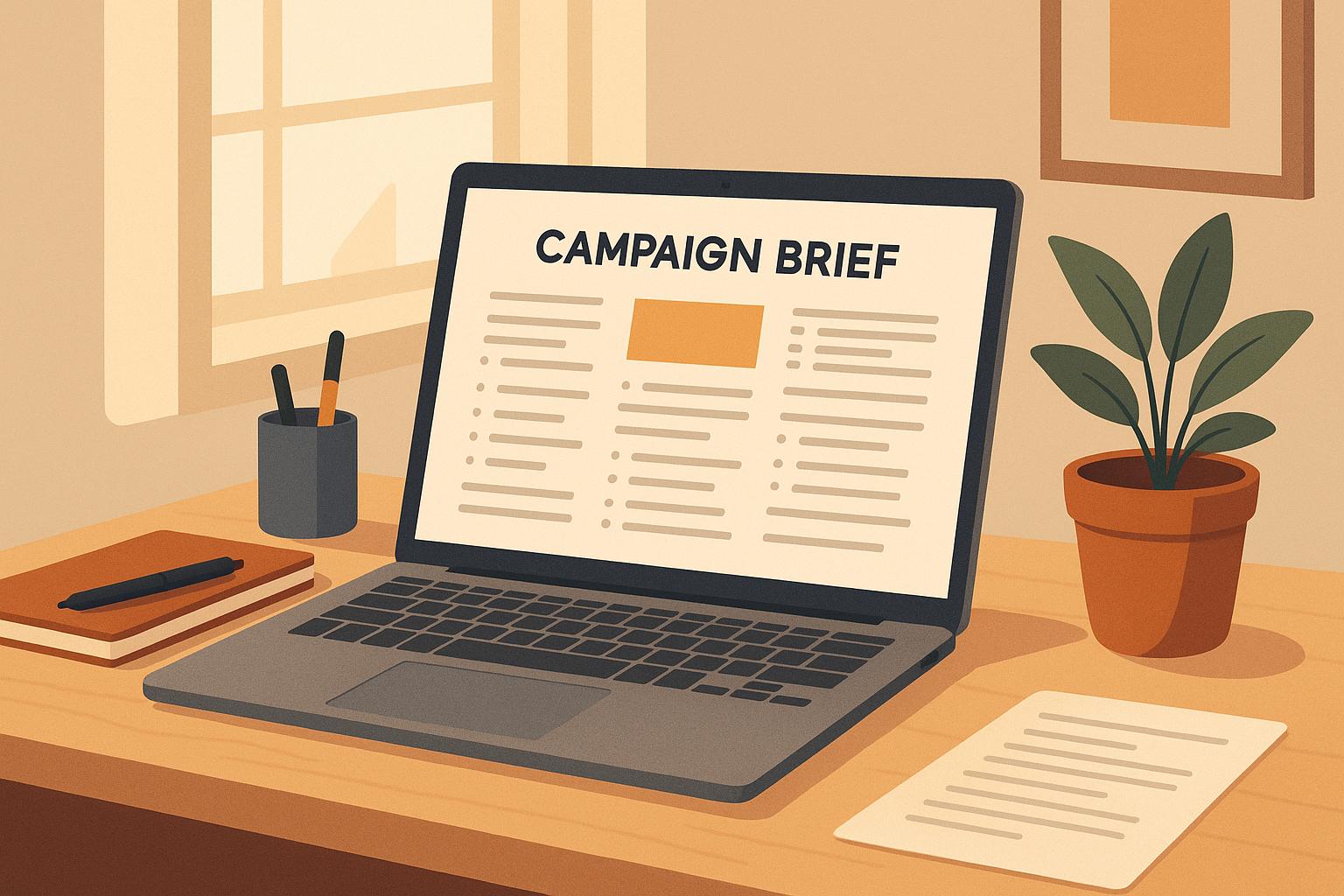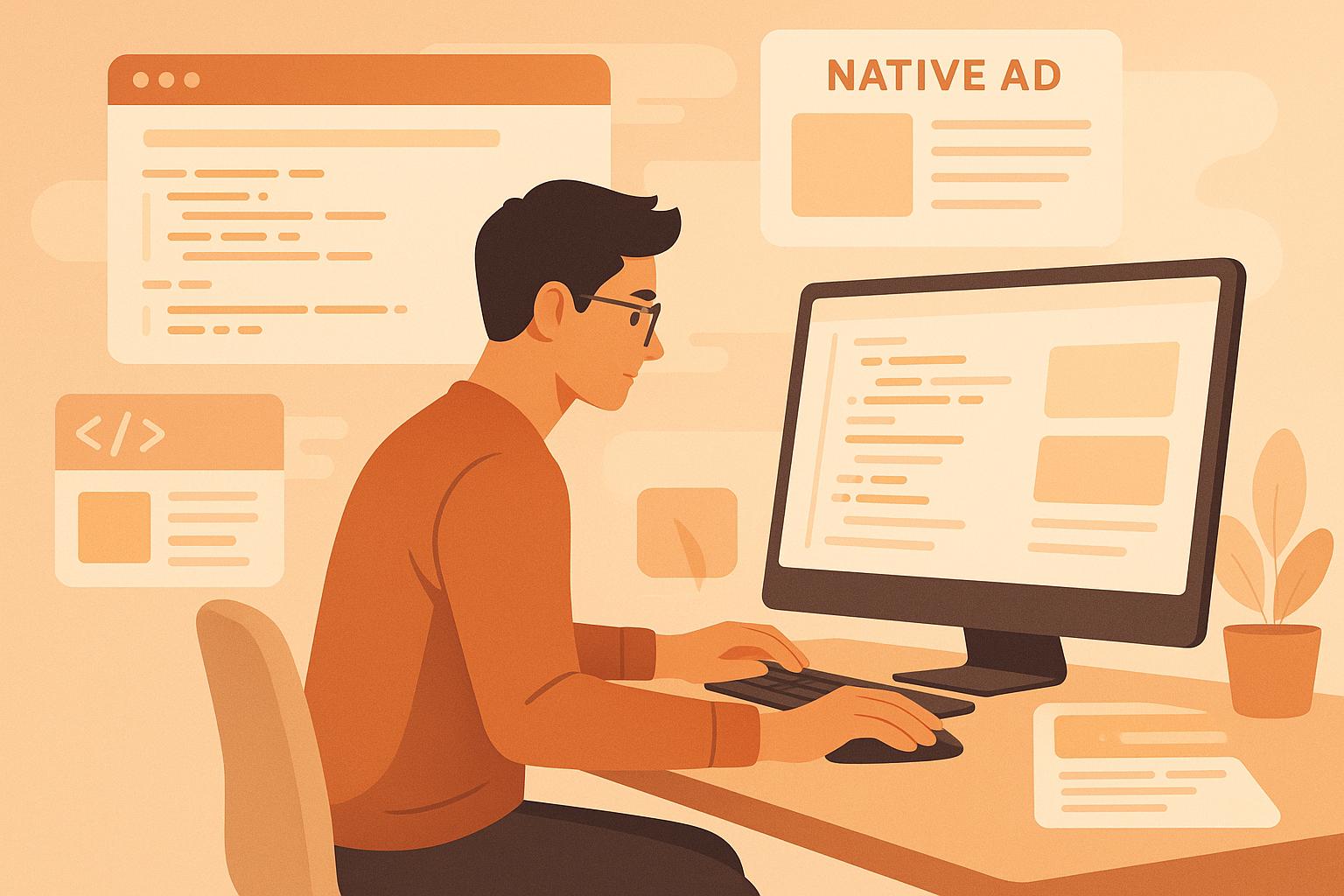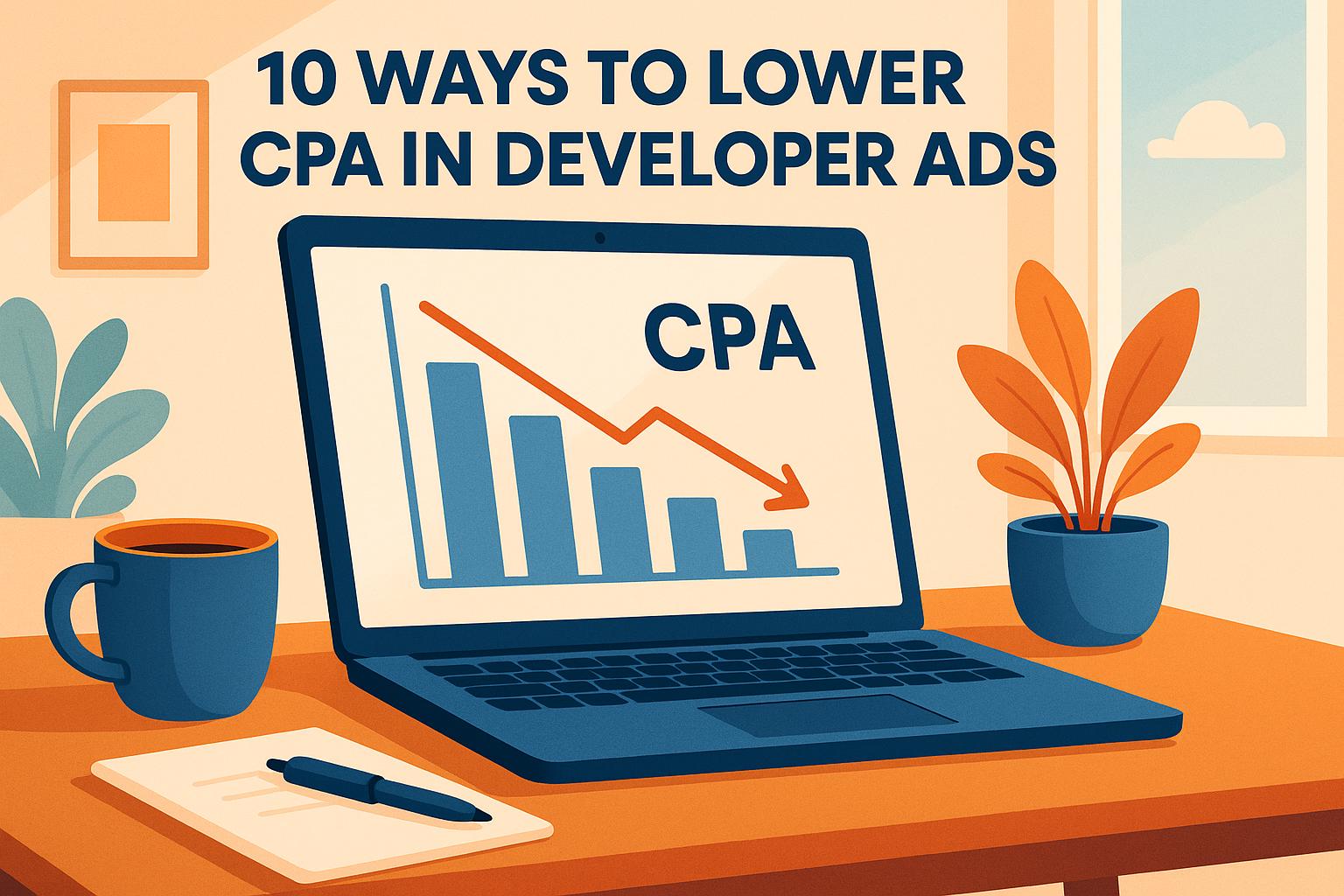


Craft a precise developer campaign brief that aligns your team and resonates with developers, focusing on clear objectives and targeted messaging.
Marketing to developers is different. They prefer technical accuracy over flashy ads and value precision. To succeed, you need a well-structured campaign brief that aligns your team and resonates with this audience.
Here’s what makes an effective developer campaign brief:
- Clear Objectives: Use the SMART framework to set measurable goals (e.g., increase API adoption by 25% in 6 months).
- Audience Insights: Identify technical preferences, seniority levels, and platforms developers use (e.g., GitHub, Stack Overflow).
- Precise Messaging: Address developer challenges with clear, technical solutions - avoid jargon overload.
- Platform Strategy: Choose platforms like daily.dev Ads or newsletters to meet developers where they are.
- Budget & Timeline: Allocate resources (e.g., 40% for ads, 30% for content) and plan realistic schedules.
A strong brief ensures your team is aligned, keeps your messaging on point, and helps you achieve better results with developers.
How I think about Developer Marketing
Core Components of a Developer Campaign Brief
A strong developer campaign brief is all about clarity and focus. It should include the key elements that align your team and ensure your campaign resonates with developers.
Setting Clear Objectives
Your campaign objectives are the backbone of your strategy. Using the SMART framework - Specific, Measurable, Achievable, Relevant, and Time-bound - can significantly increase your chances of success. In fact, research shows that marketers who set goals are 429% more likely to report success, with 81% of those achieving their targets.
When targeting developers, your goals could be as specific as increasing API adoption by 25% within six months, generating 500 qualified leads for your developer tools by the end of 2025, or elevating brand awareness among senior developers by 40% in Q2 2025.
As Philip Kotler puts it:
"Marketing objectives are essential for any organization that wants to raise awareness about itself, its products, or its services."
Carmen Williams, Chief Evolution Officer at Evolve for Growth, adds:
"Marketing objectives need to be reasonable and attainable but also push you." [3]
Your brief should clearly outline whether your campaign is focused on brand awareness, lead generation, product adoption, or building a developer community. This clarity ensures everyone is on the same page and helps define the metrics you’ll use to measure success.
Once your objectives are set, the next step is understanding the developers you're trying to reach.
Identifying Your Developer Audience
To connect with developers, you need to go beyond surface-level demographics. Dive into their technical preferences, seniority levels, and workflows. Are you targeting frontend developers working with React, backend engineers using Python, or DevOps experts managing cloud infrastructure? Each group has unique needs and challenges.
Consider their experience levels too. Junior developers may look for learning resources, while senior architects or CTOs focus on scalability and efficiency. Also, think about their work environments - startups versus large enterprises - and where they consume information. Platforms like Stack Overflow, GitHub, newsletters, podcasts, and video tutorials are common sources.
These insights will shape your messaging and help you choose the best platforms for engagement.
Writing Key Messages
Developers value authenticity and technical accuracy over flashy marketing. Your messaging should address their specific challenges with clear, credible solutions.
Start with a strong value proposition. Explain the problem your product solves and how it makes developers' work easier, faster, or more reliable. Highlight tangible benefits, like reducing deployment times or simplifying integrations.
Use technical language that resonates with your audience, but avoid overloading them with jargon. For example, when targeting Python developers, mention relevant libraries and frameworks. If your audience is DevOps engineers, talk about CI/CD pipelines and infrastructure as code.
Back up your claims with proof. Include performance benchmarks, security certifications, open-source contributions, or testimonials from respected voices in the developer community. Credibility is key to earning trust.
Once your messaging is solid, the next step is figuring out where to share it.
Choosing Advertising Platforms
To reach developers effectively, you need to meet them where they are. Choose platforms that align with their habits and tailor your ads to fit the platform’s context. For instance:
- Native ads can increase engagement by up to 53%.
- Static banner ads capture the attention of over 30% of developers.
- On Stack Overflow, 83% of conversions happen without a click.
- Nearly 40% of developers click on links in newsletters.
Platforms like daily.dev Ads offer ad placements specifically designed for developers, such as in-feed ads, post page ads, and personalized digest ads. With targeting options based on seniority, programming languages, and tools, you can ensure your message reaches the right audience at the right time.
Detail the platforms that best fit your campaign goals, along with the ad formats, targeting options, and expected engagement metrics for each.
Budget and Timeline Planning
Your budget and timeline should reflect the scope of your campaign. Break your budget into clear categories, such as:
- 40% for ad spend
- 30% for content creation
- 20% for tools and platforms
- 10% for measurement and optimization
For timelines, use a structured approach. Developer campaigns typically require:
- 2–4 weeks for planning and content creation
- 4–8 weeks for execution
- 1–2 weeks for analysis and optimization
Set milestones like content delivery dates, campaign launch, and performance reviews. Include buffer periods for technical validations or A/B testing, as developer-focused content often requires extra scrutiny.
Don’t forget to account for external factors like developer events, product launches, or seasonal trends that could influence your campaign’s performance. A well-thought-out schedule and budget keep everything on track and ensure all components work together seamlessly.
Developer Audience Research and Segmentation
Getting to know your developer audience goes beyond surface-level understanding - it’s about diving into their behaviors, preferences, and challenges. This knowledge is the foundation for creating campaigns that truly connect with the developer community. By conducting detailed research, you can segment your audience effectively and deliver tailored experiences that lead to better outcomes.
Data-Driven Audience Research
To start, understanding how developers interact with your product is key. User behavior analytics (UBA) is a powerful tool for this, as it tracks navigation patterns and engagement levels. It sheds light on how developers use your product and where they might encounter obstacles.
Keep an eye on metrics like feature usage, click rates, funnel drop-offs, session frequency, adoption rates, activation, referrals, churn, monthly recurring revenue (MRR), annual recurring revenue (ARR), and retention. These numbers give you a complete view of user engagement.
Analyzing user behavior often involves methods like A/B testing, segmentation analysis, funnel tracking, and retention studies. To go even deeper, combine these quantitative methods with qualitative tools like user surveys, heatmaps, and session recordings. Even machine learning can play a role by identifying patterns in larger datasets.
Take Under Armour, for example. By using UBA, they spotted gaps in how users engaged with their mobile race training plans. Adjustments based on these insights led to a threefold increase in usage among paid users. This kind of research sets the stage for precise audience segmentation.
Audience Segmentation Techniques
Once you’ve gathered meaningful data, segmentation allows you to zero in on specific groups within your audience. By dividing developers into categories based on shared characteristics, you can craft messages that resonate on a personal level. This is especially important for developers, as their technical preferences and experience levels can vary significantly.
Consider this: 81% of customers expect personalized experiences, and segmented email campaigns boast a 14.3% higher open rate. Companies that use data-driven segmentation are up to 10 times more likely to achieve substantial growth.
For developer audiences, you can segment based on factors like programming languages, seniority, company size, or tech stack. A case study with VERB Brands illustrates the power of this approach. By dividing their audience into groups such as "digitally disconnected", "traditional luxury consumers", and "luxury advocates", they achieved a 221% increase in inbound leads and a 53% boost in website traffic.
To refine your segmentation, use tools like personas and journey maps. A/B testing can further help you fine-tune your approach. Platforms like daily.dev Ads make it easy to target developers precisely, allowing you to focus your messaging on specific roles, preferred tools, or programming languages. This segmentation not only sharpens your campaigns but also enables real-time adjustments for better results.
Using Analytics for Campaign Refinement
Segmentation insights are just the beginning. Real-time analytics take your campaigns to the next level, turning them into dynamic efforts that adapt and improve continuously.
"Everyone loves shiny creatives and big budgets, but without solid attribution, you're throwing money into a black hole. The ugliest part of marketing [analytics] is often the most profitable." – Grady Cool, Strategic Investor
Before launching any campaign, it’s essential to define your attribution model. This ensures your resources are spent wisely and your efforts are measurable. Centralizing campaign data in a single dashboard can break down silos, making it easier to track performance and focus on actionable insights instead of vanity metrics.
For instance, AAA Alliance Club (ACA) saved 1,560 work hours by consolidating their paid social campaign analytics and automating reporting. This process uncovered valuable insights that had gone unnoticed before. Setting clear goals and key performance indicators (KPIs) upfront, while regularly auditing your data collection methods, can lead to meaningful improvements.
Another example comes from Babbel, the language learning app. They created a Product Performance team to monitor how updates impacted user behavior. By using curated analytics templates, they could track results in real time, which shortened release cycles and improved content production.
Finally, cloud storage solutions not only enhance data security but also ensure your analytics are always accessible. This makes it easier to refine campaigns and keep improving over time.
sbb-itb-e54ba74
Tools and Templates for Brief Creation
Crafting effective developer campaign briefs becomes much easier with the right tools and templates. Instead of starting from scratch every time, you can rely on proven frameworks to streamline the process and maintain consistency across your campaigns. A well-thought-out template serves as the foundation for your campaign's strategy.
Ready-to-Use Brief Templates
A solid template acts as a roadmap for your campaign, ensuring your creative teams stay aligned. As industry experts note, "A creative brief is a living document that provides direction for creative teams and sets out project goals". The goal is to create templates that include all the essential elements without overwhelming your team with unnecessary details.
At Ziflow, their Creative Project Manager developed a comprehensive template using the Goals, Audience, Creative, Channels (GACC) framework. This structured approach supports the clarity and precision needed for developer campaigns.
For campaigns targeting developers, your template should include critical elements such as objectives, audience specifics (like programming languages, seniority levels, or company size), messaging and tone guidelines, business goals, competitive analysis, timelines, budget details, deliverables, distribution channels, creative guidelines, key benefits, and reference materials. If you're working with platforms like daily.dev Ads, you'll also want to outline targeting parameters, including developer roles, preferred tools, and technology stacks.
Investing in a well-rounded template saves time and reduces revisions. "The more complete a creative brief, the fewer revisions there will be later". This is especially true for developer campaigns, where technical accuracy and relevance are key to success.
Collaboration Tools for Brief Development
Successful campaigns thrive on seamless collaboration. Marketing collaboration tools help keep teams aligned, reduce the need for frequent meetings, and ensure everyone has access to the information they need.
Different tools excel in various aspects of brief development. Asana is great for managing marketing projects, helping teams organize tasks, set deadlines, and assign responsibilities. Trello is particularly useful for tracking content creation phases.
For managing feedback, Filestage simplifies the review and approval process. Miro is ideal for brainstorming sessions and initial strategy discussions. Design and marketing teams can collaborate effectively on creative concepts using Figma.
Platforms like ClickUp provide a shared workspace for team collaboration, while monday.com focuses on balancing workloads across team members. For teams working with large creative files, LucidLink offers real-time storage collaboration, ensuring everyone has up-to-date access to assets.
The key is to select tools that integrate well with each other, streamlining your entire marketing process. For daily.dev Ads campaigns, you'll need platforms that allow easy sharing of targeting details, creative specifications, and performance metrics across your team. Once your templates and tools are in place, a checklist can help ensure no detail is overlooked.
Brief Completion Checklists
Even the best templates and tools won’t guarantee success without a thorough review process. Checklists improve accuracy by clearly outlining tasks, deadlines, and goals, while also fostering collaboration and continuous improvement [18]. As Atul Gawande, author of The Checklist Manifesto, puts it: "Under conditions of complexity, not only are checklists a help, they are required for success. And the reason is increasingly evident: the volume and complexity of what we know has exceeded our individual ability to deliver its benefits correctly, safely, or reliably".
For example, Insurance Company XYZ adopted a digital checklist solution using Manifestly's marketing campaign checklist. This led to a 30% reduction in campaign launch times and improved accuracy, resulting in greater customer engagement and satisfaction.
When creating a checklist for developer campaign briefs, make sure it covers objectives, audience details, key messages, platform choices, budgets, timelines, creative requirements, and approval processes. These checklists help minimize errors and ensure consistency. Regularly update them to reflect changes in your projects, and involve your team in their creation and review to ensure they remain practical and effective.
When integrated into your project workflows, detailed checklists become powerful tools for maintaining quality and consistency across all your developer campaigns. They’re not just about ticking boxes - they’re about ensuring every part of your campaign is as strong as it can be.
Conclusion
A well-crafted developer campaign brief lays the groundwork for success by ensuring clarity and alignment from the start.
The brief acts as your campaign’s guiding light, helping every team member stay on the same page about goals, audience, and messaging. When done right, it eliminates confusion, prevents missed deadlines, and avoids budget overruns. It’s the difference between a campaign that delivers and one that falls flat.
When working with developers, technical accuracy and authenticity are non-negotiable. Your brief should reflect this by including specifics like programming languages, skill levels, and the unique challenges developers encounter daily. Vague or generic messaging simply won’t resonate with this audience.
Getting these details right doesn’t just build trust - it ensures your message performs well on the platforms where developers are active. Platforms like daily.dev Ads make it possible to connect with over 1 million developers globally through targeted placements. This level of precision ensures your campaign reaches the right audience, maximizing its impact.
The tools, templates, and checklists shared in this guide aren’t just helpful - they’re essential for creating a repeatable, efficient process. As you refine your approach with each campaign, your briefs will become sharper, your teams more aligned, and your results more measurable. These frameworks are the backbone of any successful developer-focused campaign.
Keep in mind that a great brief isn’t static - it evolves with data and feedback. The most effective campaigns start with a strong brief and adapt along the way based on performance insights.
Download the template, align your team, and pick the right platforms to kick off your next campaign with confidence.
FAQs
How do I use the SMART framework to set clear goals for a developer-focused marketing campaign?
To set clear goals for a developer-focused marketing campaign, consider using the SMART framework. This approach ensures your objectives are well-defined and actionable:
- Specific: Pinpoint exactly what you aim to accomplish, like boosting developer sign-ups or increasing engagement.
- Measurable: Track progress with concrete metrics - think a 20% increase in sign-ups or gaining 1,000 new users in a month.
- Achievable: Make sure your goals are realistic, considering your available resources, budget, and timeline.
- Relevant: Ensure your objectives align with your overall business and marketing goals.
- Time-bound: Set a clear deadline, such as reaching your target within three months.
By sticking to these principles, you can create a campaign with clear direction and measurable success.
How can I identify and understand the unique needs and preferences of developer audiences?
To connect meaningfully with developers, start by diving into their pain points, goals, and everyday habits. Check out developer forums, social media groups, and online communities to understand what challenges they face and what piques their interest. Your messaging should aim to provide real value - whether that means offering solutions to their problems or making their work processes smoother.
Get involved directly by asking for their feedback and being active in their spaces. Use tools like surveys, polls, or even casual conversations to sharpen your understanding. Keep refining your approach based on their responses and shifting trends so your campaigns stay relevant and impactful.
What are the best platforms to advertise to developers, and how can I adapt my messaging for these platforms?
To connect with developers effectively, focus your efforts on platforms where they actively participate, such as LinkedIn, GitHub, X (formerly Twitter), Reddit, and niche developer forums. These are the spaces where developers share ideas, solve problems, and network with peers.
When shaping your message, prioritize technical value and practical solutions. Keep your language direct and clear, incorporating technical terms that align with their expertise. Developers appreciate messaging that highlights innovation, community engagement, and solutions to the challenges they encounter. Adapting your tone and approach to match the unique culture of each platform will help your message stand out and feel genuine.






